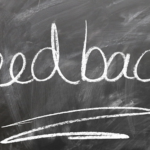
Karen Van Eylen & Ann Deketelaere
Technology is increasingly important in educational practice. While there is a widespread use of a variety of e-tools, digital competences are typically taken for granted and are hardly questioned. This study examines students’ perspectives on challenges and benefits of using an ePortfolio. In particular, we assess how student engagement can be increased and supported by their supervisors, and question students on their digital competences. The Medical School at KU Leuven uses an ePortfolio in the undergraduate program for medical doctors during their internships. Three student groups were questioned, two Bachelor’s and one Master’s group. Although the student groups share the same perception on benefits, challenges, engagement and support, they differ in the perception of their digital competences. The Master’s group felt less competent than the Bachelor’s group who are more familiar with technology in their spare time. The findings suggest although these students can be considered as digital natives, in educational contexts they still feel unconfident in using e-tools. Teachers need to pay more attention to students’ digital awareness and take actions to enhance their digital competences.
Introduction
Technology is omnipresent. We are not always aware of the implications of this evolution and the importance of becoming competent in enhancing these challenges. The European Commission (2017) points out the importance of digital competences for citizens on coping with this invasion of technology in our everyday life. They offer the European Digital Competence Framework for Citizens, also known as DigComp, as a tool to improve citizens’ digital competence for work and employability, learning, leisure, consumption and participation in society. Within this framework, the competences are described in different areas: information and data literacy, communication and interaction, digital content creation, problem solving and safety. Being digital competent means by this framework that people need to have competences in each of these five areas.
Within education, some projects focus on identifying and describing emerging technologies who likely have an impact on learning, teaching, and creative inquiry in education. For instance, the NMC report that is annually produced to point out the key trends, challenges and important developments on technology in education. In the report of 2017, ’improving digital literacy’ is proven a significant but solvable challenge. As they state in their report ”Institutions are charged with developing students’ digital citizenship, ensuring mastery of responsible and appropriate technology use, including online communication etiquette and digital rights and responsibilities in blended and online learning settings and beyond.” (NMC Horizon Report 2017, 24). The importance of staff engaging student in being digital competent to prepare them for work, society and lifelong learning is also pointed out by Resnick (2002, 33, via White 2013): “In the years ahead, digital fluency will become a prerequisite for obtaining jobs, participating meaningfully in society, and learning throughout a lifetime.”
Portfolios in education are widely used to collect learning artefacts and are known to be a tool for supporting students in their learning process (Snadden & Thomas 1998b). With the evolution to competence-based curricula, many educational programs use ePortfolios to support and assess students’ learning in these competencies. Putting the ’e’ in front of portfolio brings also the challenge to the student of proving his/her digital competences. While introducing ePortfolios in students’ educational program, very little attention is paid on how digital competent students really are. According to Ellis et al. (2005), students not always seem to be sure on how to use available tools to optimize learning. Thereby, the correct use of available digital tools by students cannot be taken for granted (Lust et al. 2011). It is therefore useful to question the perceptions of students of their digital competency in using an ePortfolio.
Context
This article is a result of a collaboration between the Educational Development Unit of KU Leuven and the Medical School. We jointly analyzed students’ ePortfolio experiences within an Erasmus+ project called ’Empowering ePortfolio Process’ (EEP). This project examines the use of an ePortfolio (i.e., a digital portfolio) as a digital tool for learning in competence-based education where students’ engagement plays a crucial role. In this learning process, the importance of supervision and critical reflection is crucial to enhance learning (Snadden and Thomas 1998b) and another focus of this study.
The faculty of medicine uses an ePortfolio in the undergraduate program for medical doctors during their internships, called ’clinical clerkships’. Between their first and second year, Bachelor’s students perform a two weeks nursing clinical clerkship in a hospital to become familiar with the patient in a hospital setting and practice their technical-clinical skills. In December of the second Bachelor year, they have a one-week clinical clerkship in a family doctor’s practice. The aim is to be introduced in the patientcare in primary health care setting and to practice their communication skills. Within the medical training, the KU Leuven uses the CanMEDS framework to identify and describe the roles and competencies of a physician.
A clinical clerkship in Medical Education could be formulated as composed of three structural roles or actors and their mutual relationships: the clinical clerk (student), the clinical department (regional hospital) and the Medical School (university). This “trio” constitutes the clerkship triangle. The Medical School remains final responsible for the learning process of the clinical clerk, despites its absence in the clinical setting due to geographical distance. In this sense an ePortfolio works as an artifact for the pedagogical steering from a distance, by the Medical School, not only of the learning process by the clinical clerks, but also of the supervision process by the clinical supervisors (Deketelaere 2010) (See Figure 1).

The portfolio system is used in a formative way to guide the doctors in training in their learning process. Throughout the ePortfolio, students must integrate learning tasks in order to support their self-organized learning. Assignments are meant to stimulate broad and deep reflection. Students also have to reflect on the competencies in preparation of a feedback talk with their supervisor and they set new goals to structure their personal learning. Thus, the portfolio is not only used as a tool to document and structure the learning experiences in the clinical setting, but is also an intensive feedback tool to support communication between the three actors in the clerkship triangle: the student, the clinical supervisors and the medical school.
Therefore, the KU Leuven uses specially tailored ePortfolio tool called ’Toledo Portfolio1’ (De Massière et al. 2012). The strength of this tool is its user-friendly feedback tool: a student can ask feedback on an assignment or self-evaluation, simply by sending an email with a link to this assignment. The person who gives feedback can be anyone and must not be recognized by the system, nor use a login. Within the clinical environment where a student is guided by several persons (medical doctors, residents, nurses…), this is a very user-friendly system to ask and receive feedback. Students keep the ownership of their ePortfolio regarding the content (including collecting data) and are responsible to engage in communication with supervisors and mentors.
In the article at hand, we focus on students perspectives. We are particularly interested in the challenges and benefits of the current use of ePortfolio and their perceptions on how the ePortfolio system and guidance by the supervisors can support them in their learning process throughout formative assessment. On the other hand, we want to know how students perceive their digital competences in using the current ePortfolio system called Toledo Portfolio.
Methodology
In this study, we approached three different student groups in the same curriculum of the Medical School. We selected from three years the entire group of students who followed a pedagogical introduction course to become a peer teacher. The students involved in this study are already more involved in educational practice and therefore probably more willing to participate. Two groups of students are in the Bachelor’s years and the other group is in their Master’s.
While questioning the students, we informed them about the European Project. Two student groups, consisting of Bachelor’s students, were questioned on their experience of their nursing internship during the 2015 and 2016 summer and their patientcare internship in December 2016. The third student group, consisting of Master’s students, had no experiences beforehand with the ePortfolio, and were interrogated on their perception of their digital competencies in general.
The data was collected by the use of a questionnaire send out by e-mail to 20 Bachelor’s students and eight Master’s students. Open response questions were used to gather qualitative data. The response rate was 46% (n=7 Master’s, n=6 Bachelor’s). Within the group of 20 Bachelor’s students, half of the students reported not being included in the ePortfolio pilot in 2015 and therefore could not participate in the survey. Data analysis was driven by two pillars: one on collecting the broad variety of answers due to the exploratory focus of this study and the other on frequency of answers given.
Results
In the remainder of the article, we present a summary of the students’ responses. With the exception of digital competences, we do not distinguish between Bachelor’s and Master’s students as both student groups deliver similar insights.
Students’ perspectives on benefits and challenges in using ePortfolio
According to the survey, students observe benefits in using a digital ePortfolio. First, they consider it as accessible and adjustable at all times, at least when there is an internet connection. Second, different actors can simultaneously view the ePortfolio without adjusting their agenda as to when and where. Third, students do not have to keep paper forms, which can get lost, and everything is kept in the same place. Two students mentioned it to be ecofriendly since they do not have to print paper. Fourth, the ePortfolio system is user friendly as students can easily adjust the content. Fifth, students appreciate the general overview, not only in the tasks within this internship but also across different internships as assignments, communication and deadlines are centralized within one system.
Nevertheless, students observe various challenges as it requires digital competences from students and supervisors, there are connectivity issues and it does not replace human interaction. We discuss these challenges into more detail.
First, students do not always feel digital competent and feel unsure in using an ePortfolio. A student indicates: ’The platform is a new digital system and you need to give yourself time to learn to work with it.’ Students also indicate that supervisors do not always have sufficient digital competences to adequately use the ePortfolio. This is, reflected, for instance, in the timely and poor feedback students receive. A reason could be that feedback requests get lost in all the other e-mail traffic.
Second, although accessible at all time, using an ePortfolio is not without constraints. One needs internet access, which is not always available, sometimes due to the firewall within the hospital. You also need to have a portable e-device or computer. When you are working with patients, it is not always easy to have a computer nearby. This makes that students are deliberately planning in their agenda the time to fill out the ePortfolio. When using a smartphone, the online site you are using for the ePortfolio must have a mobile version to be user-friendly.
One student noted that in the beginning she printed everything so she could work on it when she had a few minutes of spare time. Students also suggest to integrate more the different digital platforms were they have to find information to reduce workload. Some of them noted that an ePortfolio could not replace human interaction. Written feedback is useful to document what is said during the supervision talks, but cannot replace them.
Students’ perspectives on how supervisors can engage their students
Students articulated that their need to be engaged derives from both external as internal motivation. From an external point of view, the use of clear deadlines helped them in filling out their ePortfolio as well as getting grades for fulfilling assignments amongst all other obligated assignments. Upon that, one student said that ‘It would be better to get a specific grade rather than just to know whether you pass or not. In that way I would feel more appreciated for the work I did.’
However, they see the intrinsic benefit of working with an ePortfolios to support and steer their learning process. In particular, the ePortfolio can help students in articulating their own development plan and focus on their personal learning needs.
Students fear that receiving guidance only through an ePortfolio, however, creates a distance between different actors and increases the anonymity. Students argue that face-to-face interaction and regular feedback on ePortfolio assignments would be two suggestions to increase the engagement for the ePortfolio. In addition, providing information sessions on how to use the ePortfolio system would be helpful. Not only for themselves, but also for the clinical supervisors.
Students’ perspectives on guidance and evaluation for student engagement
Students expressed the importance of making their own learning process visible. In particular, they would like to observe their own learning curve, and have an overview of the learning goals integrated in the ePortfolio. The ability to point out their own strengths and weaknesses in relation to the learning goals was considered valuable. It helps them to structure whatever is needed to learn and to keep focus on what is important. The ePortfolio is an excellent tool to work on self-reflection by articulating own learning goals and monitoring their own personal growth. One student noted that she ‘was not aware of the many learning goals in that specific domain’ and so she focused on developing her competences on the level that was required.
Receiving feedback helps students to guide the learning process. Written feedback in open answers is to be found more useful than grading by numbers leaving much less interpretation on how to improve.
Students’ perspectives on digital competences and required support
With respect to the digital competences, we noticed a significant difference in responses of the Bachelor’s and Master’s students. The age difference between both groups is relatively small, approximately six years. We asked them to estimate their own digital competences. The answers of the Master’s students are graded on the whole continuum of ’not good’ to ’good’, whereas the Bachelor’s students answered ’rather good’ to ’good’. The ones who answered ’good’, work a lot with digital systems and computers in their free time or are children of engineers and informatics. Overall, Bachelor’s students seem not to be afraid to try out and to find their own solutions when they work with digital information/tools, whereas Master’s students ask for a formal introduction and more guidance in how to use the ePortfolio.
Questioned on the support students would like to have, they all indicated the usefulness of having information sessions to explain how the ePortfolio works. It is important for having confidence in the system that everything is done correctly and kept safe. The more user-friendly and intuitive the online platform is build, the easier it is to work with. Still there are individual differences: some want to have a manual whilst others want to discover the tool by using it.
Discussion
The discussion focuses on the conclusions of the students’ engagement in ePortfolio and the perception on its use related to their own digital competencies as formulated by the Framework of the European Commission.
In general, students are positive on the use of ePortfolio, because of the user-friendliness, respect for ecology and the flexibility in access and modification. The advantage of collecting and storing all the learning artefacts in one place assures them not to lose any information. However, they are concerned about the digital literacy of their supervisors and them finding time to read the assignments and give proper feedback.
An important condition to work with the ePortfolio system is the need to have a computer or e-device and internet access. This might sometimes be a problem due to firewalls in the hospital. Van Tartwijk and Driessen (2009) point out that an ePortfolio requires a stable and high quality information technology infrastructure. They discussed upon Lawson et al. (2004) that limited computer access in the clinical workplace can even cancel out the advantages of user-friendliness and may have an opposite effect.
The ePortfolio is a tool to make more meaning of students’ academic and clinical education that clearly engages them in the ePortfolio process. (Although some of them still want to be more encouraged by strict deadlines or grades for their effort.) Overall, they mention that the ePortfolio is a good tool to make their own learning visible. Within the clinical environment, students tend to focus more on “working” than on “learning”, because they participate active in patient care. The learning goals and assignments make this learning visible for the clinical supervisors and the Medical School. The electronic format gives both the opportunity to give feedback in a quick and user-friendly way and steer their future learning from a distance.
In this perspective, communication with supervisors as guidance counselors is found crucial for the learning process (Deketelaere 2010). Regular feedback is necessary to support and guide them in the learning process (Driessen et al. 2007). Within the Toledo ePortfolio, the supervisors are invited to give comments and feedback on specific artefacts in the ePortfolio. Students stress that the eFeedback should be seen complementary to face-to-face guidance and can never replace it.
It is remarkable that students in their responses often speak not only from their point of view but also try to fill in the needs of their supervisors. For example, they try to clarify that teachers need to become more digital confident and that they are coping with time restraint issues due to giving feedback and the amount of administrative workload. So we can state that they are well aware of what is applicable for them also translates in what is important for the supervisor who is an active user of the ePortfolio as well.
The differences between the two groups of students with more and less experience on using ePortfolio were minimal, except concerning digital competences. The Master’s students had more difficulty in finding themselves digital competent concerning problem solving while the younger Bachelor’s students described themselves as the generation of ’trial and error’. Despite the small sample size, we observed a pertinent difference in digital literacy that cannot be ignored. Some of the students who felt competent in using technology, articulated to be more involved in computers and technology due to their experiences in their own context, suggesting that their ’expertise’ is not a result of the educational program. Yet, Ng (2012) concludes that students who nowadays have unlimited access to using online technologies, do not use tools for educational purposes to create artefacts online. All student groups in this study gave notice that an information session on how to use the ePortfolio system would be very much appreciated and helpful.
This article has some clear policy conclusions. We need to take a close look on how we train our students in their own digital awareness and define the necessary support to make them feel more competent. We cannot assume that they are sufficiently digital competent. This points out that within the educational program more attention has to be paid on improving students’ digital competency. Moreover, we need to invest in professional development and ongoing support for our staff. This is essential to help faculties contextualize digital literacies within their disciplines and help them on how to engage in student-staff partnerships (NMC report 2017).
Do we teach students to be digital competent by implementing an ePortfolio? In the scope of the European Digital Competence Framework, we have to invest more in the aspects of digital content creation and safety, as well as how digital problem solving can be addressed. It is clear that we do provide students with the opportunity to work with digital data, let them engage in digital communication and interaction, but we cannot ignore the need to educate students and staff in their digital competences.

This article was produced in the Erasmus+ (KA2 action) funded project “Empowering Eportfolio Process (EEP)”. The beneficiary in the project is Häme University of Applied Sciences (FI) and the partners are VIA University College (DK), Katholieke Universiteit KU Leuven (BE), University College Leuven-Limburg (BE), Polytechnic Institute of Setúbal (PT) and Marino Institute of Education (IE). The project was implementated during 1.9.2016–30.11.2018.
Authors

Karen Van Eylen, MsC, currently works as an educational technologist at the Educational Development Unit at KU Leuven. She advises and assists teaching staff and educational developers concerning appropriate technologies for education. Evidence-based research is an important starting point for this support. Her work focuses on e-assessment, formative assessment and digital tools; technology in collaborative learning and service-learning.

Ann Deketelaere studied Educational Sciences and obtained a Phd in Biomedical Sciences on learning with portfolio in clinical workplaces. She actually works part-time as a senior staff member at the Educational Support office of the faculty of Medicine (KU Leuven). She is also involved in the training of teacher educators (Faculty of Psychology and Educational Sciences, KU Leuven). Her main fields of interest are workplace learning and portfolio.
References
Associatie KU Leuven. (2017). Portfolio – Het Toledo Portfolio. Retrieved 12 May 2017 from http://toledo.kuleuven.be/portfolio
Canmeds Framework. Canmeds consortium. Retrieved 15 May 2017 from http://www.royalcollege.ca/rcsite/canmeds-e
Deketelaere A, (2010). Learning with a portfolio in clinical workplaces. Practices, pitfalls and perspectives. Doctoral thesis in Medical Sciences. Antwerpen: Garant.
De Mazière, P, Deketelaere A, Debrabandere S, De Schreye R, & Strijbos J. (2012) Een moderne kijk op e-portfolio concepten. OnderwijsInnovatie 3, 32–35.
Driessen, E., Van Tartwijk, J., Van Der Vleuten, C., & Wass, V. (2007). Portfolios in medical education: why do they meet with mixed success? A systematic review. Medical education, 41(12), 1224–1233.
Ellis, R. A., Marcus, G., & Taylor, R. (2005). Learning through inquiry: student difficulties with online course‐based Material. Journal of Computer Assisted Learning, 21(4), 239–252.
Erasmus + EEP (2017). EEP Empowering ePortfolio Process. Retrieved 16 May 2017 from https://eepeu.wordpress.com
European Commission. (2017). Digital Competence Framework. Retrieved 12 May 2017 from https://ec.europa.eu/jrc/en/digcomp/digital-competence-framework
Lawson M, Nestel D, & Jolly B. (2004). An e-portfolio in heath professional education. Med Educ 38:569–570.
Lust, G., Vandewaetere, M., Ceulemans, E., Elen, J., & Clarebout, G. (2011). Tool-use in a blended undergraduate course: In Search of user profiles. Computers & Education, 57(3), 2135—2144.
Ng, W. (2012). Can we teach digital natives digital literacy? Computers & Education, 59(3), 1065—1078.
NMC report (2017). Horizon Report. Retrieved 12 May 2017 from http://cdn.nmc.org/media/2017-nmc-horizon-report-he-EN.pdf
Resnick, M. (2002). Rethinking learning in the digital age. In Kirkman, G., Cornelius, P., Sachs, J., & Schwab, K. (EDs). The global information technology report 2001–2002. New York: Oxford, 4.
Snadden, D, & Thomas, ML. (1998b). The use of portfolio learning in medical education. Med Teach, 20, 192–199.
Van Tartwijk, J., & Driessen, E. W. (2009). Portfolios for assessment and learning: AMEE Guide no. 45. Medical teacher, 31(9), 790—801.
White, G. K. (2013). Digital fluency: Skills necessary for learning in the digital age. Australian Council for Educational Research. Melbourne: ACER, 10, 1—13. Retrieved 8 January 2018 from https://research.acer.edu.au/cgi/viewcontent.cgi?article=1006&context=digital_learning





